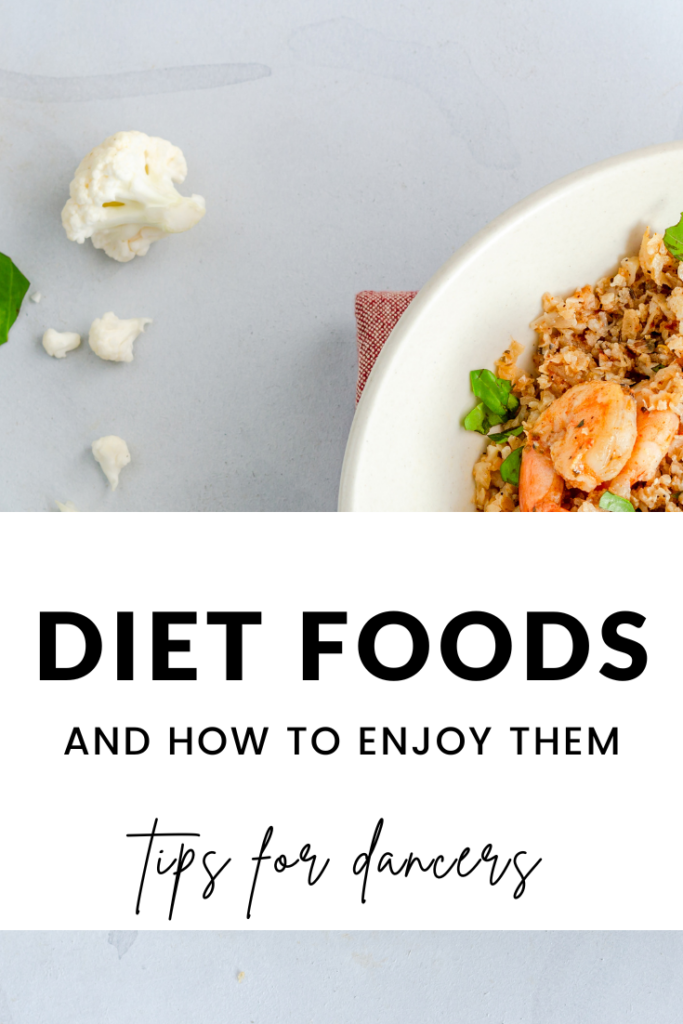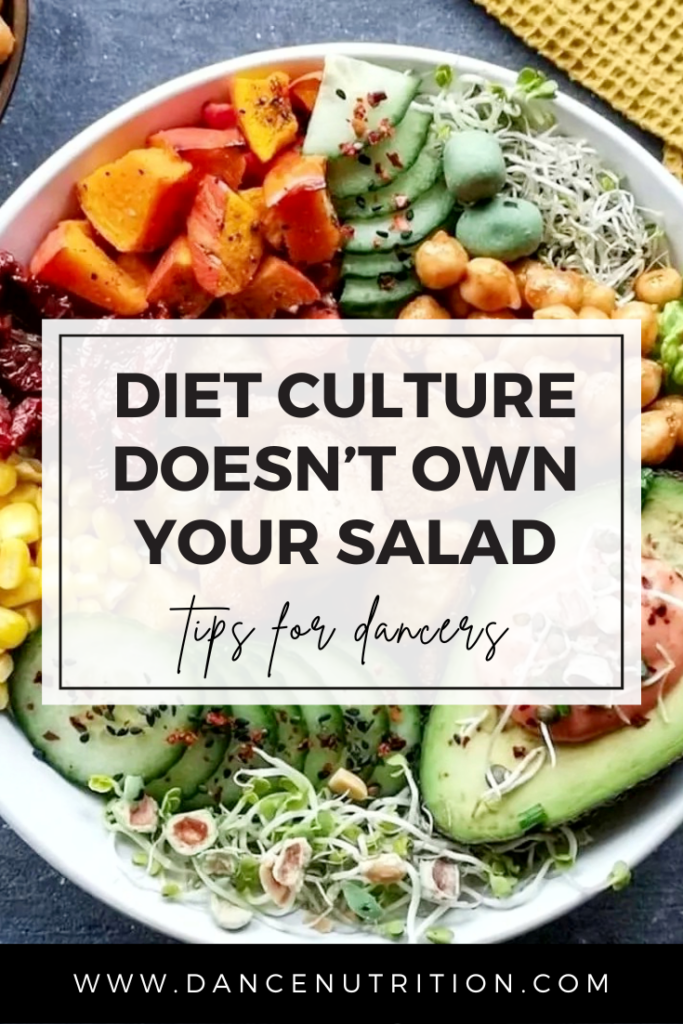I once thought that a veggie-loaded salad (dressing on the side) was sufficient for lunch. Not only did it check the boxes of a “healthy” meal, but it also filled me physically and, according to what I thought was right for a dancer, gave me the reassurance of control— the hope that if I continued to do everything “right,” I would achieve not just performance success, but also, dancer body goals (thankfully, I came to realize all of this was wildly unsupportive and unrealistic).
Rather than being filled with that supposed “success” however, I grew increasingly obsessed with food— a victim of “clean” eating. I felt frustrated at meals, stressed about eating foods not deemed “clean,” and drained during classes. Was this seemingly “healthy” salad actually supporting me?
Dancers and Diet Food
In their pursuit to diet or eat “clean,” many dancers label certain foods as “good,” deeming them more acceptable and superior when compared to other foods. But as previously discussed, both dieting and clean eating are gateways to disordered eating, if not an eating disorder. It isn’t until a dancer begins their journey toward healing from diet culture that things shift. Through this shift, even the “cleanest” foods— some include salad, cottage cheese, cauliflower rice (or pizza), and rice cakes start to trigger a degree of PTSD.
Contrary to popular belief, healing our relationships with food isn’t just about learning how to eat fun foods without guilt. It’s about eating ALL foods— those that are accessible and preferred, without guilt, shame, or fear. This article will review the 5 most common “clean” (diet) foods consumed by dancers, and how to enjoy them in a way that no longer feels limited or restrictive.
#1: Salad
Salads are top of the “clean” food list for most dancers— a vehicle for colorful veggies and other minimally processed ingredients like grains, beans, lentils, and oils. Even the most well-intended dancers can construct a salad that provides a balanced mix of carbohydrates, protein, and fats. But if that mix is continuously made to be unsatisfying, or it’s used to replace a craving (such as for a heartier sandwich) then dancers will ultimately struggle to accept salads as a non-diet option.
To challenge this, rethink your salad and what it has to offer: a world of culinary possibilities beyond just lettuce and greens. The goal? Prioritize its staying power or the degree to which it satisfies you until your next opportunity to eat. To do this, add ingredients rich in fiber, protein, and fat. Here are some examples:
10 satisfying ingredients to add to your salad
- Cheese (shredded or cubed)
- Avocado
- Creamy or oil-based dressings
- Slivered nuts
- Dried Fruit like raisins or cranberries
- Legumes like chickpeas or lentils
- Carbs! Croutons or wonton strips
- More carbs! Grains like Farro, Quinoa, Barley, or Rice, or a side of toasted sourdough
- Seeds like pepitas, sunflower Seeds, or hemp seeds
- A whole egg (not just egg whites!)
#2: Cottage Cheese
Cottage cheese is often seen as a go-to food for dieters and “clean” eaters alike due to its high protein content and relatively low-calorie count. Spoiler: this isn’t a reason to include it in your dancer meal plan. Yes, cottage cheese is packed with protein, making it an excellent choice for maintaining muscle— a bonus for dancers. But it’s also incredibly versatile. You can use it in sweet dishes like smoothies and desserts (think cheesecake bites) or savory recipes like lasagna, or stuffed peppers. Its creamy texture and mild flavor make it a flexible ingredient.
#3: Cauliflower Rice
Cauliflower rice has gained popularity as a low-carb substitute for traditional rice, but I’ll say this loud and clear: cauliflower rice is not a carb and therefore, shouldn’t substitute the carb in your meal. As a vegetable, however, it’s super fun and versatile. One of the perks of cauliflower rice is its ability to absorb flavors from your seasonings and sauces. This means you can infuse it with your favorite tastes, making it a versatile base for various dishes. Use it as a veggie addition to add some fibrous bulk to your fried rice.
#4: Spaghetti Squash
Spaghetti squash is particularly unique in its stringy, pasta-like texture when cooked, It’s a rich source of vitamins and minerals, including vitamin C, potassium, and fiber, which supports digestive health and helps regulate blood sugar. Similar to cauliflower rice though, spaghetti squash shouldn’t be a substitute for the carb in your meal (ie. pasta). Rather, incorporate it as a veggie for a variety of sauces, like tomato or pesto, mixed alongside other veggies, pastas, and proteins.
#5: Lentil Pasta
Lentil pasta is undeniably a fantastic choice for those seeking a nutrient-dense and versatile meal. This single food covers a lot of groundwork— extra helpful for quick and easy meals. Lentil pasta is packed with plant-based protein and fiber, offering a range of benefits like digestive regularity and sustained energy. If short on time, lentil pasta is naturally balanced even without the addition of a protein.
Despite these benefits, lentil pasta isn’t superior to traditional pasta. In fact, any pasta (even traditional “white” or wheat pasta) can be a fantastic and energizing addition when incorporated into an otherwise balanced meal. To gain the benefits of both, seamlessly integrate lentil pasta into your meal plan when it’s accessible. By doing so, you can enjoy the best of both worlds: the comfort of traditional pasta and the nutritional boost of lentils, creating a diverse and satisfying experience.
#6: Quinoa
Quinoa is undeniably a fan favorite among dancers and rightfully so— this versatile ingredient is considered a complete protein, containing all nine essential amino acids need for muscle growth. This unique nutritional profile also makes an excellent choice for vegetarians and vegans. But while quinoa offers these advantages, it isn’t necessarily superior to other grains like rice. Rice, a staple in many cultures, provides essential carbohydrates and is more affordable in comparison. It also offers a comforting and familiar taste that complements a wide range of dishes. Ultimately, the choice between quinoa and rice depends on individual preferences, with both offering unique benefits.
#7: Rice Cakes
Rice cakes are probably the top diet food of the ’90s and early 2000s. To be honest, rice cakes are often considered “air food,” a low-calorie food that is limited in its ability to offer a satisfying experience. However, when incorporated into a balanced recipe, rice cakes can be surprisingly versatile— adding a delightful crunch, albeit you’re a fan of crunch!
One innovative way to use rice cakes is to turn them into mini “pizzas.” Spread a layer of tomato sauce or pesto on a rice cake, sprinkle with your favorite toppings like shredded cheese, diced vegetables, or even some protein like chicken or tofu, and then bake until the cheese melts for a crispy, guilt-free pizza alternative. You’ll want to pair this with another source of carbohydrates, though! Another option is to make rice cake sushi. Top rice cakes with a layer of sushi rice, your choice of thinly sliced raw fish, avocado, and/or sliced cucumber. Drizzle with soy sauce or sriracha mayo. For something sweet, crush your rice cakes and incorporate in no-bake oat bites— dipped in melted chocolate and then topped with colorful sprinkles, nuts, or dried fruit.
#8: Nut Butter
Nut butter, whether it’s almond, peanut, or cashew, offers a great source of heart-healthy fats, protein, and various vitamins and minerals like Vitamin E. “Natural” options are often boasted for their simplicity while traditional nut butter (ie. Skippy and Jif) are sometimes ridiculed for containing added sugars or oils. However, obsessing over ingredients can quickly turn your nut butter habit from supportive to obsessive. Traditional nut butter is widely available and budget-friendly, making them excellent pantry staples that promote satiety and provide a sustainable source of energy. For more ingredient myth-busting, read this article on sugar and this one on processed foods.
A Dancer’s Guide to “Clean” Ingredients: Key Takeaways
These ingredients are not intended to be used as “clean” swaps for other foods. Rather, use a food-neutral lens to view these foods as is: ingredients. Each of these options offers a range of nutritional benefits and culinary possibilities, helping to enhance any balanced meal plan. But a food’s nutritional value doesn’t have to outweigh factors like personal preferences and food accessibility. While dancers can utilize tools like nutrient density in their decision-making, practicing flexibility at meal times is equally essential (here’s an article to learn more about this).




